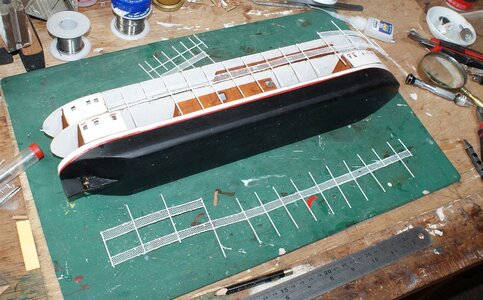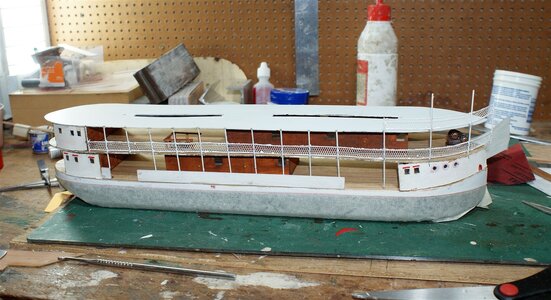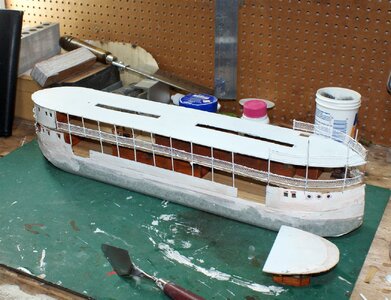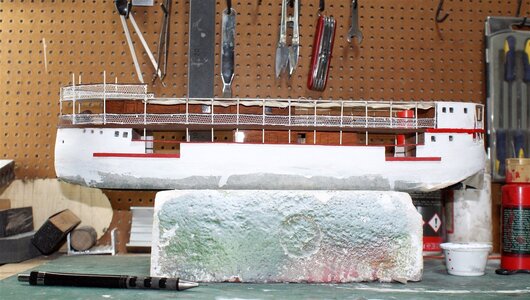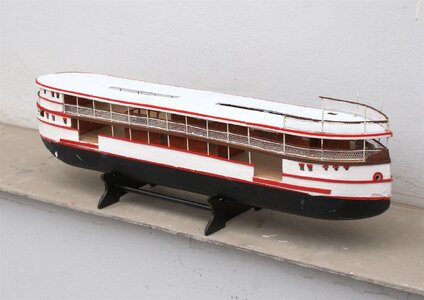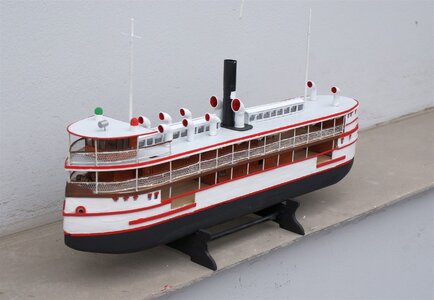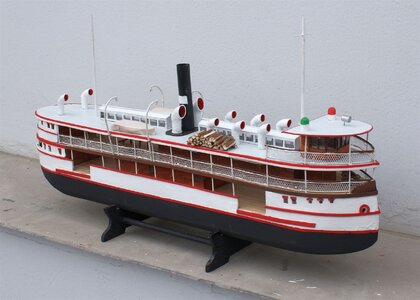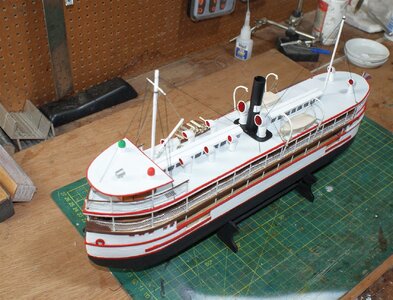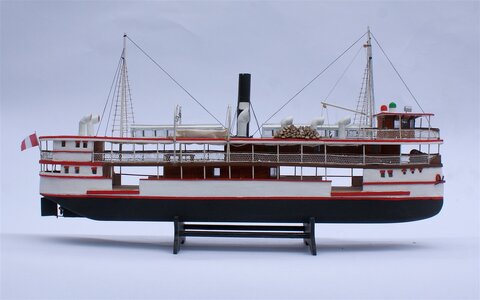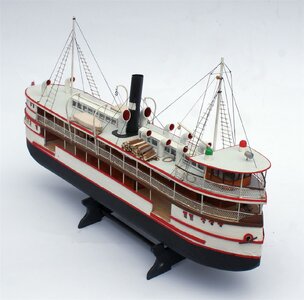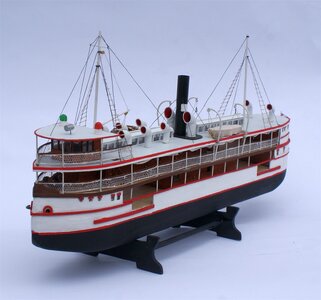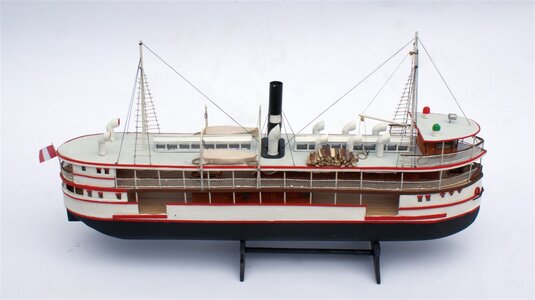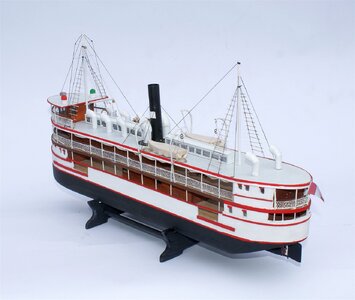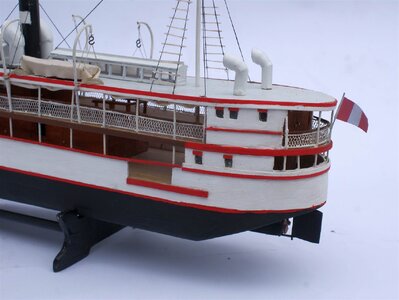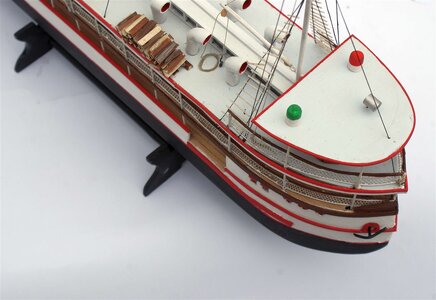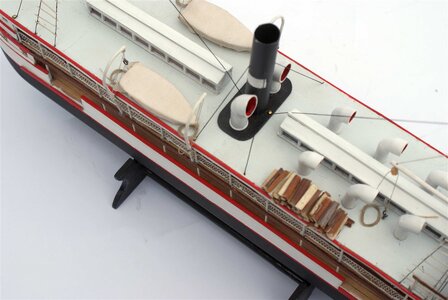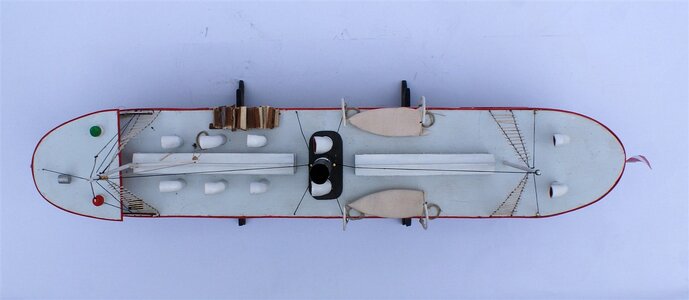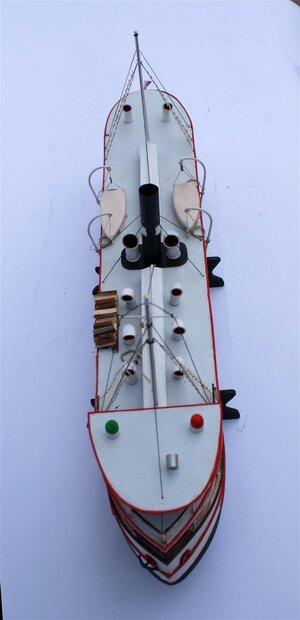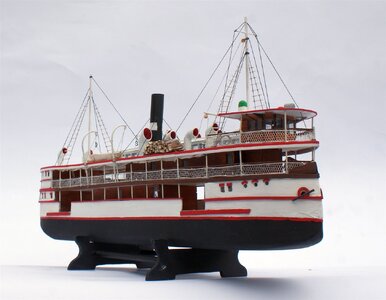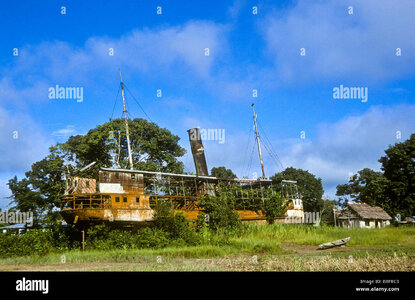This week I present to you a ship from my country, Peru. The model is that of the “Moly Aida”, the star ship of the film “Fitzcarraldo” which was set in the Peruvian Amazon. This 1982 German film was directed by Werner Herzog and starred Klaus Kinski, Claudia Cardinale. My work was based on the photo of the model found in the Deutsche Kinemathek museum (Berlin).
MOLLY AIDA
1. HISTORY
The model I propose is that of a river-type steamboat, which navigates between reality and fiction. The reality is about the events in which Fermín Fitzcarrald, a Peruvian businessman at the end of the 19th century with the desire to achieve riches through the exploitation of the rubber tree, ventures into unexplored territories of the Peruvian Amazon, going up from Iquitos over the Amazon River, continues along the Ucayali River, finding the Isthmus (which bears his name) and links it to the Madre de Dios River basin and allows him to take his boat to the Madeira River and from there to the Amazon River again (To get an idea Of the distances, the trip from Iquitos to Pucallpa and from there to the isthmus is approximately 1,150 kilometers. The return to Madre de Dios is 330 km. Continuing to Manaus (Brazil) 1,700 km. and 1,600 km going up the Amazon to Iquitos, They are 4,780 km. And if you consider the twists and turns of these rivers, a journey of 6,000 kilometers can be estimated. It makes a notable discovery, not only commercially, but also geopolitically, since it opens communication between two navigable basins. and strengthens Peru's possession of those territories, which could have been invaded by Brazilian or Bolivian settlers. In reality, Fitzcarrald set sail with a steamboat or rather a steamboat that was called "Contamana" and was smaller, between 30 and 40 tons of displacement. Upon reaching the isthmus, the boat was transferred over a level difference of more than 140 meters and a journey of 11 kilometers to the other basin, it was done with dozens of natives and settlers, the boat was disassembled into pieces and transported to be assembled on the banks of the other river. The person of Fitzcarrald, his methods and his achievements can be questioned by his contemporaries (there have always been envious people) and by current ones (who want to adapt the actions of a man from the 19th century to the criteria of the 21st century), but entrepreneurs like he was the one who united many unexplored territories in what is now Peru.
In fiction, Werner Herzog develops an epic about the character of Fitzcarrald, adventurous, daring, and about the ship "that climbed a mountain", in the film the ship is called "Molly Aida", it was a two-deck steamship. which displaces nearly 300 tons, much larger than the boat that actually did the exploration, but a filmmaker's version can take many liberties to make the sensations of the adventure more intense. The film was filmed in the same Peruvian Amazon, on a reconditioned ship, only in two scenes was a scale model used, this model is on permanent exhibition at the Deutsche Kinemathek (Berlin). Every year I travel to Germany, but the past travel I didn't have the time (dragged by my granddaughters), anyway, it will be on my next trip that I can go to Herzog's room.
In the next section, I attach a lot of reference to the areas (reality and fiction) to take into account for this project, which I try to resemble the ship that appears in the film. I do not have the plans of the ship with which they made the film (nor do I believe they exist) but based on the photographs that show the museum model, I obtained important dimensions such as length, depth, deck height, chimney dimension, masts, etc etc., other dimensions were achieved by assimilating its proportions to those of other ships (such as the Ayapua, current floating museum in Iquitos), and also remembering the 70's when working at Petroperú as a junior design engineer for oil facilities, I went to the “field ” to inspect new production batteries, drilling platforms, tanks, pumping stations, etc. We usually traveled in helicopters, but sometimes due to bad weather we embarked on similar boats, but through the Marañón basin, between San José de Saramuro, Nauta and Iquitos, because that was a two day's trip or being stranded in the middle of nowhere. . It should also be noted that the model shown by the Deutsche Kinemathek differs from the one in the film, mainly in colors and finishes. For example, in the film the hull is completely black, while in the model it is red and black. In one the cabin panels are made of wood, while the museum model is white, and so on, just details.
As I indicated previously, in my model I will try to follow the ship that appears in the movie as much as possible. In the first photos The Molly Aida sets sail upstream of the Amazon, to later enter the Ucayali; in the second one, she is “climbing the mountain” on the isthmus; In the third, the model is crossing the pongo (the rapids) and in the fourth photo, the boat is listing, but has survived and is returning to Iquitos.
2. REFERENCES
About Fermín Fitzcarrald

 es-academic.com
es-academic.com

 es.wikipedia.org
https://www.elperuano.pe/noticia/57428-fermin-fitzcarrald
es.wikipedia.org
https://www.elperuano.pe/noticia/57428-fermin-fitzcarrald
About geography

 es.wikipedia.org
https://kripkit.com/istmo-de-fitzcarrald/
es.wikipedia.org
https://kripkit.com/istmo-de-fitzcarrald/
About the movie
 es.wikipedia.org
es.wikipedia.org

 www.filmaffinity.com
www.filmaffinity.com
 catalogo.artium.eus
https://www.deutsche-kinemathek.de/en/gallery/fitzcarraldo
catalogo.artium.eus
https://www.deutsche-kinemathek.de/en/gallery/fitzcarraldo
Complete movie in Spanish
About the model

 www.modelshipsinthecinema.com
https://www.tagesspiegel.de/kultur/kino/kinski-ahoi-6823609.html
www.modelshipsinthecinema.com
https://www.tagesspiegel.de/kultur/kino/kinski-ahoi-6823609.html
3. GENERAL INFORMATION
MOLLY AIDA
Amazon basin
Country: Perú
Type: Steamboat
Function Trade, exploration
Scale 1:100
Total Length 39.62 m (396 mm)
Length 39.62 m (396 mm)
Total Height 17.53 m (175 mm)
Beam 7.00 m (70 mm)
Draft 3.00 m (30 mm)
4. WORK PROCEDURE
The ship is a common model of ships from that time (and today), but I took the dimensions from a photo of the ship model that is in the Deutsche Kinemathek, I entered the photo into AutoCAD and began to obtain dimensions and verify data (40 m in length, 7 m in width and 1.30 m in draft, it achieved about 360 tons of displacement, consistent with what was expected), heights between decks of 2.3 meters and so on. I made a template of the shape of the first deck, as well as the bow and stern profile; Watching the film, we took note of the position of the stairs between decks and the type of panels. Elevation plans were made to later proceed to laser cutting and facilitate the work.
The Amazon steamboats have the hull of a barge, that is, a rectangular section, a flat bottom, a slightly raised bow and a cut-out stern to facilitate the propeller and rudder. Having little draft, I considered it impractical to make the hull by the false keel and frames method, rather I considered it would be easier to make it than a piece of solid wood. Well, I didn't have a piece of that size, but I did have some pieces of pine (they came with the new kitchen dishwasher) measuring 25x40x400 mm and I glued them, achieving a good size of 75x40x400 and now what to do , I had never made carvings. Except for a jigsaw and a back plane, I didn't have suitable tools, so I just had to do it with patience.
After achieving the expected dimensions, I put a layer of wood sealer and white glue, then sanded it (120, 240, 320) and finally two coats of very diluted lacquer so that it did not absorb too much paint. I opted to paint the hull black with a slight red line also placed a propeller (12 mm diameter) and the rudder (in black) whose shape I observed from the film (not from the photo of the model).
With the plan view of the hull, I have taken the shape of the decks and then I will proceed to make their planking only in the visible parts. I think that the progress to date has been the easy part, now comes all the detail of the two decks and bridge, the decking, preparation of the panels, doors and windows, chimney, air intakes, skylights, masts, boats , railings, posts, stairs. I'll see how it goes, because it's the first time that I intend to build a boat without a specific plan and that isn't under sail, I just have to be patient, and if I get bored, then I'll intersperse with another one.
Based on the photograph of the Molly Aida taken from the model exhibited in the Museum (see references), dimensions were taken and a plan was drawn in CAD that was later cut with a laser to have the covers, details and partitions. The decking was made with 0.5 x 3mm veneer strips, as it would not be visible it was left uneven. The first planking was glued to the wooden hull and then the partition walls forming 3 sectors at the bow, stern and central (it was previously painted and stained in mahogany color). Afterwards, the second deck was placed, already planked, and the partition walls were mounted on it, forming 2 sectors aft and central; An opening was left for the staircase. The third deck was assembled and the cockpit, boats and some details were prepared.
The vents were made with 3/8” and 1/4” copper elbows cut at 45° and soldered to tubes with tin, painted white on the outside and red on the inside. The railings were made with 0.5 mm copper wire and the posts with 1mm wire. The dimensions between posts were taken along the edge and a template was made for the cut wires and soldering these with tin. After gluing with cyanoacrylate a mosquito net and everything was painted white. It is the first time that I solder with tin and to tell the truth, the finish has been a little “rough”, it was applied and glued to the sides of the boat, there the differences in horizontality in the decks jumped out, 1 mm is noticeable from a distance (Corrections will be for next time).
The railings on the sides of the ship were placed and painted in red and the third deck on which it was mounted was prepared: the cockpit, the two central teatines, the bow and stern vents, the chimney (painted in black), the auxiliary firewood store, the foremast and mizzen masts, the auxiliary boats covered with their canvas and their davits, the anchor with the tiller inside the hull.
In this penultimate stage, we use black thread for the stays and shrouds of the foresail and mizzen masts, black thread is also used for the funnel stabilizers and ecru thread, the lifting ropes for the auxiliary boats, the loading arm fixed to the ratchet pole with its ropes and blocks. Finally, we need the shrouds with their rigid arrows and fixing the flag, it will be a few more days.
Finished, it is the first time I have made a boat of this style and the truth is it was more complicated than it seemed. There are many errors and horrors, but they will be corrected next time. I repeat the general data of the boat:
Name MOLLY AIDA
Amazon Basin Place
Country: Perú
Type: Steamboat
Function Trade, exploration
Scale 1:100
Total Length 39.62 m (396 mm)
Length 39.62 m (396 mm)
Total Height 17.53 m (175 mm)
Beam 7.00 m (70 mm)
Prop 3.00 m (30 mm)
Completion October 2022
By José Ruesta (Lima – Peru)
A compendium of this and other projects and a nice video of the boat on my blog:

 modelismonavaljoseruesta.blogspot.com
modelismonavaljoseruesta.blogspot.com
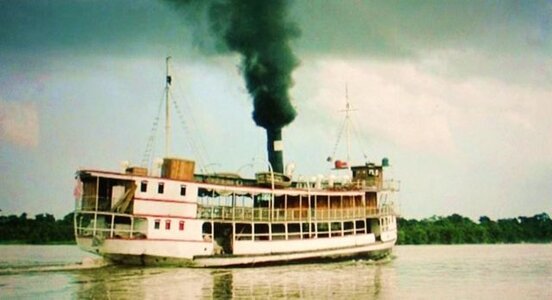
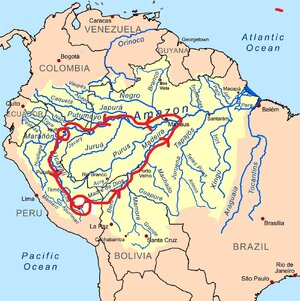
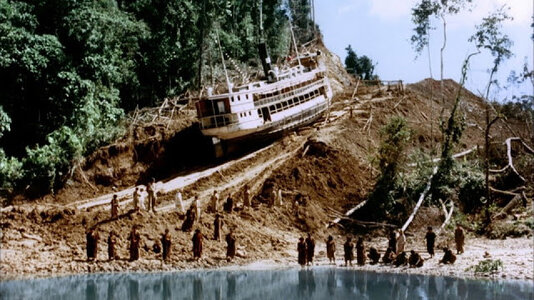
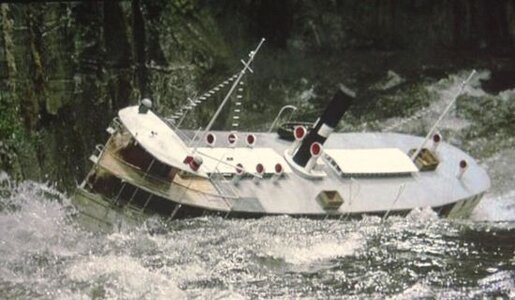
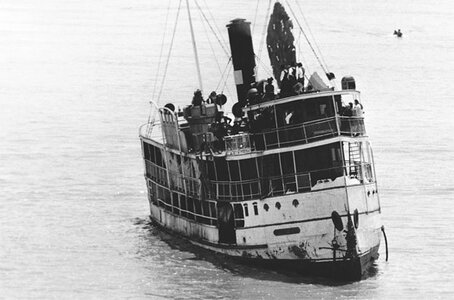
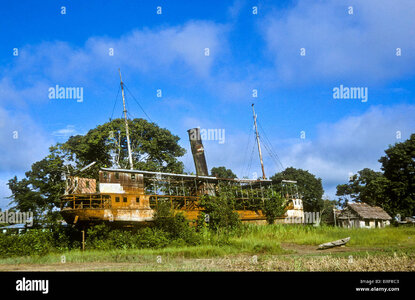
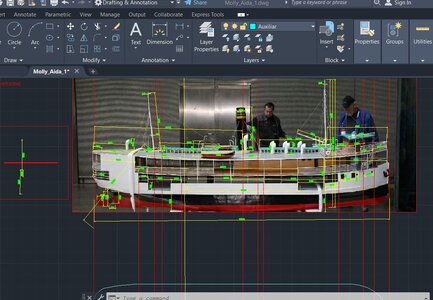
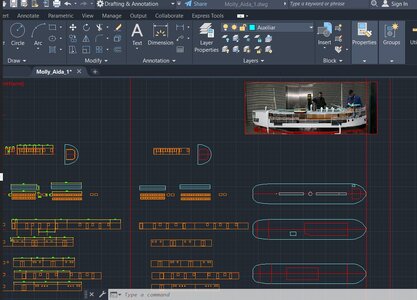
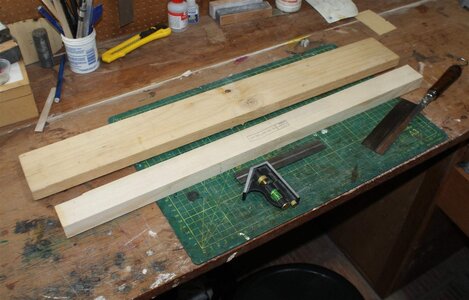
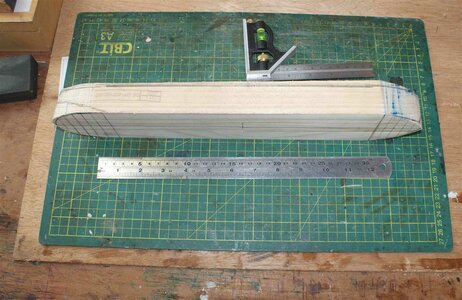
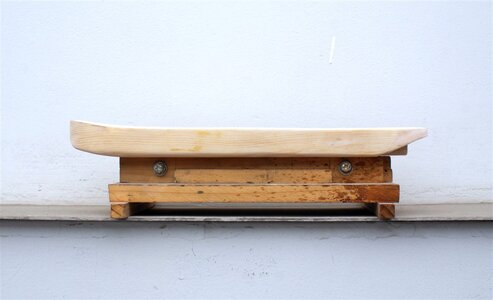
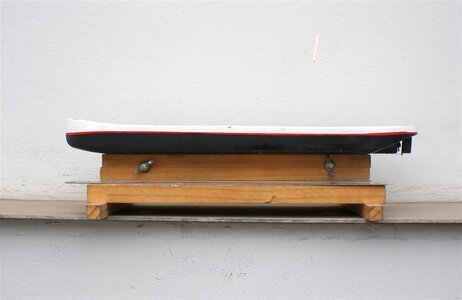
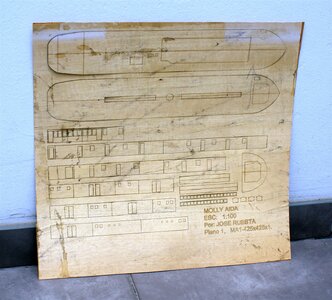
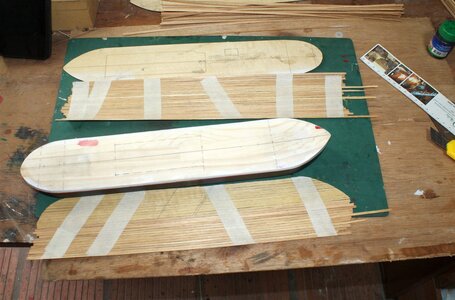
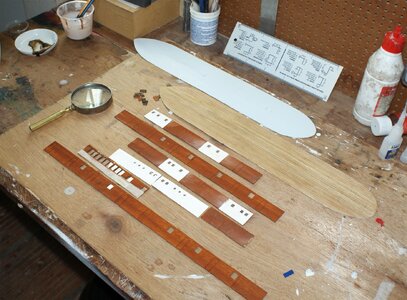
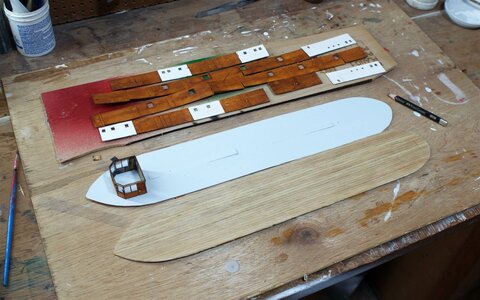
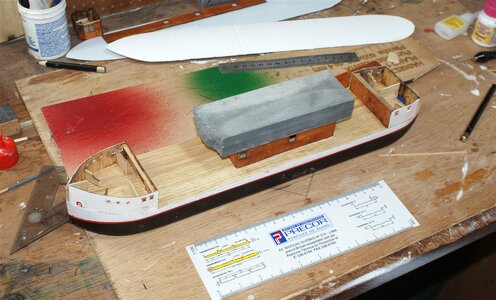
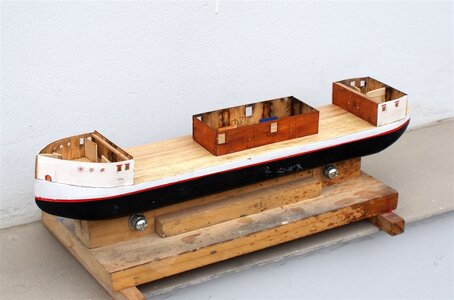
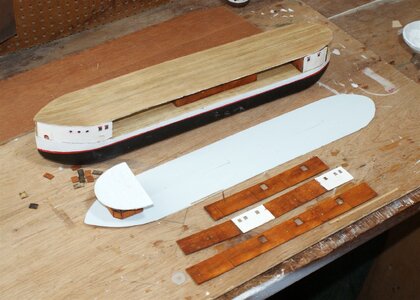
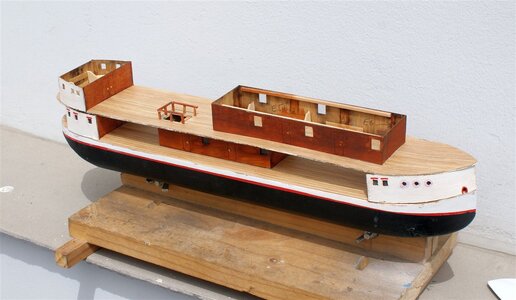
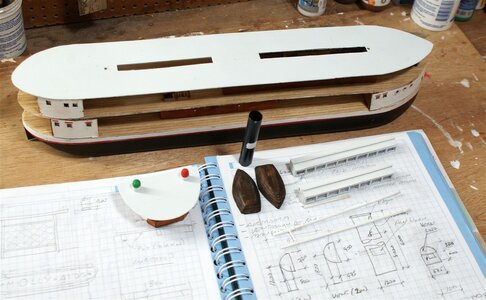
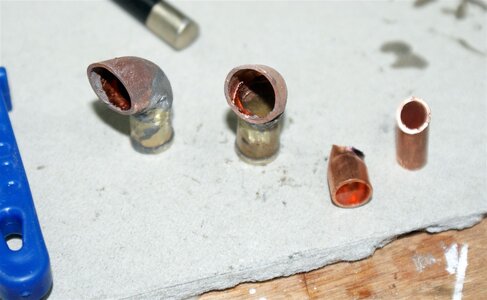
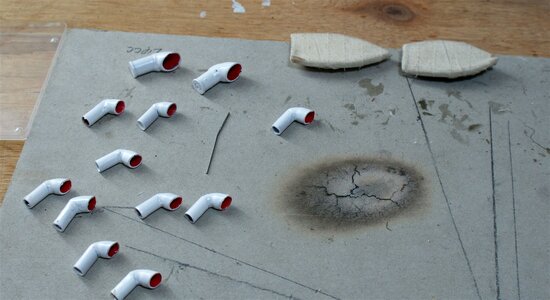
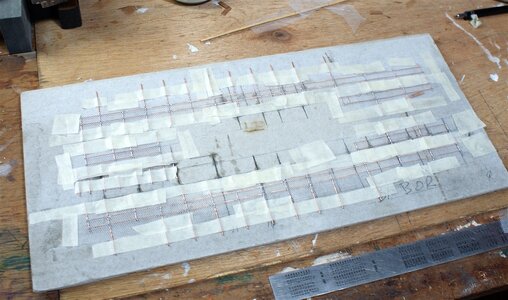
MOLLY AIDA
1. HISTORY
The model I propose is that of a river-type steamboat, which navigates between reality and fiction. The reality is about the events in which Fermín Fitzcarrald, a Peruvian businessman at the end of the 19th century with the desire to achieve riches through the exploitation of the rubber tree, ventures into unexplored territories of the Peruvian Amazon, going up from Iquitos over the Amazon River, continues along the Ucayali River, finding the Isthmus (which bears his name) and links it to the Madre de Dios River basin and allows him to take his boat to the Madeira River and from there to the Amazon River again (To get an idea Of the distances, the trip from Iquitos to Pucallpa and from there to the isthmus is approximately 1,150 kilometers. The return to Madre de Dios is 330 km. Continuing to Manaus (Brazil) 1,700 km. and 1,600 km going up the Amazon to Iquitos, They are 4,780 km. And if you consider the twists and turns of these rivers, a journey of 6,000 kilometers can be estimated. It makes a notable discovery, not only commercially, but also geopolitically, since it opens communication between two navigable basins. and strengthens Peru's possession of those territories, which could have been invaded by Brazilian or Bolivian settlers. In reality, Fitzcarrald set sail with a steamboat or rather a steamboat that was called "Contamana" and was smaller, between 30 and 40 tons of displacement. Upon reaching the isthmus, the boat was transferred over a level difference of more than 140 meters and a journey of 11 kilometers to the other basin, it was done with dozens of natives and settlers, the boat was disassembled into pieces and transported to be assembled on the banks of the other river. The person of Fitzcarrald, his methods and his achievements can be questioned by his contemporaries (there have always been envious people) and by current ones (who want to adapt the actions of a man from the 19th century to the criteria of the 21st century), but entrepreneurs like he was the one who united many unexplored territories in what is now Peru.
In fiction, Werner Herzog develops an epic about the character of Fitzcarrald, adventurous, daring, and about the ship "that climbed a mountain", in the film the ship is called "Molly Aida", it was a two-deck steamship. which displaces nearly 300 tons, much larger than the boat that actually did the exploration, but a filmmaker's version can take many liberties to make the sensations of the adventure more intense. The film was filmed in the same Peruvian Amazon, on a reconditioned ship, only in two scenes was a scale model used, this model is on permanent exhibition at the Deutsche Kinemathek (Berlin). Every year I travel to Germany, but the past travel I didn't have the time (dragged by my granddaughters), anyway, it will be on my next trip that I can go to Herzog's room.
In the next section, I attach a lot of reference to the areas (reality and fiction) to take into account for this project, which I try to resemble the ship that appears in the film. I do not have the plans of the ship with which they made the film (nor do I believe they exist) but based on the photographs that show the museum model, I obtained important dimensions such as length, depth, deck height, chimney dimension, masts, etc etc., other dimensions were achieved by assimilating its proportions to those of other ships (such as the Ayapua, current floating museum in Iquitos), and also remembering the 70's when working at Petroperú as a junior design engineer for oil facilities, I went to the “field ” to inspect new production batteries, drilling platforms, tanks, pumping stations, etc. We usually traveled in helicopters, but sometimes due to bad weather we embarked on similar boats, but through the Marañón basin, between San José de Saramuro, Nauta and Iquitos, because that was a two day's trip or being stranded in the middle of nowhere. . It should also be noted that the model shown by the Deutsche Kinemathek differs from the one in the film, mainly in colors and finishes. For example, in the film the hull is completely black, while in the model it is red and black. In one the cabin panels are made of wood, while the museum model is white, and so on, just details.
As I indicated previously, in my model I will try to follow the ship that appears in the movie as much as possible. In the first photos The Molly Aida sets sail upstream of the Amazon, to later enter the Ucayali; in the second one, she is “climbing the mountain” on the isthmus; In the third, the model is crossing the pongo (the rapids) and in the fourth photo, the boat is listing, but has survived and is returning to Iquitos.
2. REFERENCES
About Fermín Fitzcarrald

Carlos Fermín Fitzcarrald
Saltar a navegación, búsqueda Carlos Fermín Fitzcarrald López fue un comerciante cauchero peruano, que nació en la ciudad de San Luis de Huari, actual ciudad de San Luis capital de la provincia que lleva su nombre en su honor el 6 de julio de…
 es-academic.com
es-academic.com

Carlos Fermín Fitzcarrald - Wikipedia, la enciclopedia libre
About geography

Istmo de Fitzcarrald - Wikipedia, la enciclopedia libre
About the movie
Fitzcarraldo - Wikipedia, la enciclopedia libre

Fitzcarraldo (1982)
Género: Aventuras | Sinopsis: Brian Fitzgerald "Fitzcarraldo", un excéntrico y megalómano hombre de negocios obsesionado con la ópera, ha ido perdiendo su prestigio y su fortuna en absurdas empresas sin futuro. Su último proyecto ...
Fitzcarraldo - La película | ARTIUM - Biblioteca y Centro de Documentación
Complete movie in Spanish
About the model

Fitzcarraldo 1982
Despite the director Werner Herzog maintaining that everything in the film was shot for real there are a couple of model ship shots in the f...
3. GENERAL INFORMATION
MOLLY AIDA
Amazon basin
Country: Perú
Type: Steamboat
Function Trade, exploration
Scale 1:100
Total Length 39.62 m (396 mm)
Length 39.62 m (396 mm)
Total Height 17.53 m (175 mm)
Beam 7.00 m (70 mm)
Draft 3.00 m (30 mm)
4. WORK PROCEDURE
The ship is a common model of ships from that time (and today), but I took the dimensions from a photo of the ship model that is in the Deutsche Kinemathek, I entered the photo into AutoCAD and began to obtain dimensions and verify data (40 m in length, 7 m in width and 1.30 m in draft, it achieved about 360 tons of displacement, consistent with what was expected), heights between decks of 2.3 meters and so on. I made a template of the shape of the first deck, as well as the bow and stern profile; Watching the film, we took note of the position of the stairs between decks and the type of panels. Elevation plans were made to later proceed to laser cutting and facilitate the work.
The Amazon steamboats have the hull of a barge, that is, a rectangular section, a flat bottom, a slightly raised bow and a cut-out stern to facilitate the propeller and rudder. Having little draft, I considered it impractical to make the hull by the false keel and frames method, rather I considered it would be easier to make it than a piece of solid wood. Well, I didn't have a piece of that size, but I did have some pieces of pine (they came with the new kitchen dishwasher) measuring 25x40x400 mm and I glued them, achieving a good size of 75x40x400 and now what to do , I had never made carvings. Except for a jigsaw and a back plane, I didn't have suitable tools, so I just had to do it with patience.
After achieving the expected dimensions, I put a layer of wood sealer and white glue, then sanded it (120, 240, 320) and finally two coats of very diluted lacquer so that it did not absorb too much paint. I opted to paint the hull black with a slight red line also placed a propeller (12 mm diameter) and the rudder (in black) whose shape I observed from the film (not from the photo of the model).
With the plan view of the hull, I have taken the shape of the decks and then I will proceed to make their planking only in the visible parts. I think that the progress to date has been the easy part, now comes all the detail of the two decks and bridge, the decking, preparation of the panels, doors and windows, chimney, air intakes, skylights, masts, boats , railings, posts, stairs. I'll see how it goes, because it's the first time that I intend to build a boat without a specific plan and that isn't under sail, I just have to be patient, and if I get bored, then I'll intersperse with another one.
Based on the photograph of the Molly Aida taken from the model exhibited in the Museum (see references), dimensions were taken and a plan was drawn in CAD that was later cut with a laser to have the covers, details and partitions. The decking was made with 0.5 x 3mm veneer strips, as it would not be visible it was left uneven. The first planking was glued to the wooden hull and then the partition walls forming 3 sectors at the bow, stern and central (it was previously painted and stained in mahogany color). Afterwards, the second deck was placed, already planked, and the partition walls were mounted on it, forming 2 sectors aft and central; An opening was left for the staircase. The third deck was assembled and the cockpit, boats and some details were prepared.
The vents were made with 3/8” and 1/4” copper elbows cut at 45° and soldered to tubes with tin, painted white on the outside and red on the inside. The railings were made with 0.5 mm copper wire and the posts with 1mm wire. The dimensions between posts were taken along the edge and a template was made for the cut wires and soldering these with tin. After gluing with cyanoacrylate a mosquito net and everything was painted white. It is the first time that I solder with tin and to tell the truth, the finish has been a little “rough”, it was applied and glued to the sides of the boat, there the differences in horizontality in the decks jumped out, 1 mm is noticeable from a distance (Corrections will be for next time).
The railings on the sides of the ship were placed and painted in red and the third deck on which it was mounted was prepared: the cockpit, the two central teatines, the bow and stern vents, the chimney (painted in black), the auxiliary firewood store, the foremast and mizzen masts, the auxiliary boats covered with their canvas and their davits, the anchor with the tiller inside the hull.
In this penultimate stage, we use black thread for the stays and shrouds of the foresail and mizzen masts, black thread is also used for the funnel stabilizers and ecru thread, the lifting ropes for the auxiliary boats, the loading arm fixed to the ratchet pole with its ropes and blocks. Finally, we need the shrouds with their rigid arrows and fixing the flag, it will be a few more days.
Finished, it is the first time I have made a boat of this style and the truth is it was more complicated than it seemed. There are many errors and horrors, but they will be corrected next time. I repeat the general data of the boat:
Name MOLLY AIDA
Amazon Basin Place
Country: Perú
Type: Steamboat
Function Trade, exploration
Scale 1:100
Total Length 39.62 m (396 mm)
Length 39.62 m (396 mm)
Total Height 17.53 m (175 mm)
Beam 7.00 m (70 mm)
Prop 3.00 m (30 mm)
Completion October 2022
By José Ruesta (Lima – Peru)
A compendium of this and other projects and a nice video of the boat on my blog:

Mi colección
Describo la historia de varios barcos a vela y el procedimiento de armado de su modelo en madera


























